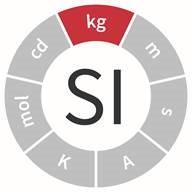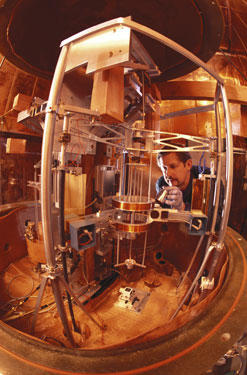SI Units - Mass

Resources for Students and Teachers | League of SI Superheroes - Monsieur Kilogram | What is the difference between the terms "mass" and "weight"?

The kilogram (kg) is defined by taking the fixed numerical value of the Planck constant h to be 6.62607015 ×10−34 when expressed in the unit J s, which is equal to kg m2 s−1, where the meter and the second are defined in terms of c and ∆νCs.

The primary standard of mass for this country is United States Prototype Kilogram 20, which is a platinum-iridium cylinder kept at NIST. The kilogram, originally defined as the mass of one cubic decimeter of water at the temperature of maximum density, was known as the Kilogram of the Archives. It was replaced after the International Metric Convention in 1875 by the International Prototype Kilogram which became the unit of mass without reference to the mass of a cubic decimeter of water or to the Kilogram of the Archives. Each country that subscribed to the International Metric Convention was assigned one or more copies of the international standards; these are known as National Prototype Meters and Kilograms. Learn more about the history and current definition of the kilogram.
Among the SI base units, the kilogram (kg) is the only one whose name and symbol, for historical reasons, include a prefix. "Kilo" the SI prefix for 1000 or 103. Names and symbols for decimal multiples and submultiples of the unit of mass are formed by attaching prefix names to the unit name "gram," and prefix symbols to the unit symbol "g." Learn more about this historical quirk.
| Units of Mass | ||
|---|---|---|
| 10 milligrams (mg) | = | 1 centigrams (cg) |
| 10 centigrams | = | 1 decigrams (dg) = 100 milligrams |
| 10 decigrams | = | 1 gram (g) |
| 10 decigrams | = | 1000 milligrams |
| 10 grams | = | 1 dekagrams (dag) |
| 10 dekagrams | = | 1 hectogram (hg) |
| 10 dekagrams | = | 100 grams |
| 10 hectograms | = | 1 kilogram (kg) |
| 10 hectograms | = | 1000 grams |
| 1000 kilograms | = | 1 megagram (Mg) or 1 metric ton (t) |

Resources for Students and Teachers
- SI Base Units Relationship Poster (SP 1247) (NIST)
- SI Units Card Deck (SP 1297) (NIST)
- Kilogram: Introduction (NIST)
- The Name "Kilogram": a Historical Quirk (BIPM)
- (Former) International Prototype Kilogram (BIPM)
- Kibble Balance Principles (NIST)
- NIST Kibble Balance – YouTube Video. (NIST)
- The NIST Do-It-Yourself Kibble Balance. (NIST)
- NIST in 90: Measuring Planck's Constant - YouTube Video. (NIST)
- What is the Planck Constant. (NIST)
- Mass Calibration Brochure. (NIST)
- Everyday Estimation - Mass. (NIST)
- Metric Kitchen - Cook and Bake with a Kitchen Scale with Grams. (NIST)
- How Do You Measure the Strength of Gravity? (NIST HDYMI Series)
- Pirates of the Caribbean (Metric Edition). (NIST)
- Pirates Plunder the Kilogram – NISTory Video Series. (NIST)
- Balancing Act. (PhET, Simulation)
- U.S. Coin Specifications. (U.S. Mint)
- Elemental Composition of the Human Body. (Visual Capitalist)
- Top 10 Tips for Teaching the Metric System (NIST)

League of SI Superheroes - Monsieur Kilogram
This comic book-style video animation series has been developed to help middle school students learn about the 7 SI base measurement units. With his immensely strong arms, Monsieur Kilogram is the master of mass. The kilogram is a cylinder of special metal about 39 millimeters wide by 39 millimeters tall that serves as the world's mass standard.
FAQ - What is the difference between the terms "mass" and "weight"?
The mass of a body is a measure of its inertial property or how much matter it contains. The weight of a body is a measure of the force exerted on it by gravity or the force needed to support it. Gravity on earth gives a body a downward acceleration of about 9.8 m/s2. In common parlance, weight is often used as a synonym for mass in weights and measures. For instance, the verb “to weigh” means “to determine the mass of” or “to have a mass of.” The incorrect use of weight in place of mass should be phased out, and the term mass used when mass is meant. The SI unit of mass is the kilogram (kg). In science and technology, the weight of a body in a particular reference frame is defined as the force that gives the body an acceleration equal to the local acceleration of free fall in that reference frame. Thus, the SI unit of the quantity weight defined in this way (force) is the newton (N).
Navigate to more SI base unit information
- SI Units
- Fundamental Physical Constants
- Length – meter (m)
- Time – second (s)
- Amount of substance – mole (mole)
- Electric current – ampere (A)
- Temperature – kelvin (K)
- Luminous intensity – candela (cd)
EXPLORE THE METRIC PROGRAM
Becoming Familiar with SI | Everyday Estimation | U.S. Metrication | U.S. Metrication FAQs | Prefixes | Metric Kitchen | SI Education and Training | SI Publications | Understanding Metric | Writing with Metric Units | National Metric Week | NEST-R (STEM Registry) | NIST Education Resources
Contacts
-
Metric Program

